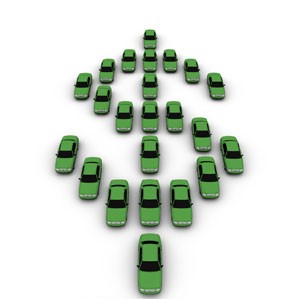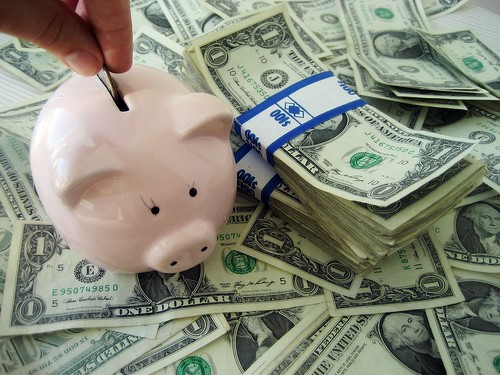December 17, 2012
 As with most major expenses, cars will not only have you shelling out on the immediate cost, but will also force you to spend more and more during the time you’re in ownership and so being able to limit expenditure is imperative.
As with most major expenses, cars will not only have you shelling out on the immediate cost, but will also force you to spend more and more during the time you’re in ownership and so being able to limit expenditure is imperative.
Remember that a car takes a lot of maintenance, as well as the constant need for fuel and the odd top up of oil; but it is the requirements of services and yearly check-ups that can cost into the hundreds and really put a strain on your finances.
There are ways for each stage of car ownership where you can find ways to be able to save money, even when buying the car in the first place, as well as bringing down fuel costs, road tax (if in the UK)and maintenance costs.
- Never ever pay the window price, every car has a target price and you should aim to get a slight percentage off of the price the showroom is suggesting. Look online for the guide price of the car(s).
- Look around to see what you should be getting for your car if part-exchanging. Check ads for cars similar to yours and what they are being valued at, as well as remembering back to what you spent on it when you bought it and whether you have added value over the years with new parts.
- If you’re in the market for a new car, but aren’t worried about the likes of garnishing it with endless optional extras that can rack the price up by a few hundred if not thousand, then ask the dealer whether they have anything new on the forecourt that is a more basic model. This also allows you to get the car earlier, instead of having to wait for it to be built at the factory.
- Try to get a deal that has a few extra benefits thrown in such as free servicing for five years or a years’ worth of free insurance, interest free APR deals are also well worth keeping an eye out for.
- For those after a new fleet car, first of all get looking for a frugal motor that is perhaps diesel-powered as opposed to petrol and then look to get a fuel card to hand from somewhere such as FCSICard.com in order to save on your VAT.
- If you’re a young driver and are considering your options in terms of insurance, try to get your parents or someone with a great deal of driving experience as a named driver which should help bring your premium down.
This is an article from FCSI Card fuel card supplier for fleet drivers in Portugal and around Europe.
Tags:
budgeting,
Car,
financial planning,
money,
Money Saving,
savings
December 13, 2012
 All businesses have overheads; those recurring costs that show up month on month. They may have little effect on the day to day running, but can have a huge impact on your bottom line. Careful monitoring will prevent overheads getting out of control and what better time than New Year, to re-evaluate the necessity of these costs and re-establish your values.
All businesses have overheads; those recurring costs that show up month on month. They may have little effect on the day to day running, but can have a huge impact on your bottom line. Careful monitoring will prevent overheads getting out of control and what better time than New Year, to re-evaluate the necessity of these costs and re-establish your values.
There are only two ways to get more money; sell more or cut back. Nobody likes the idea of a cut back, but sometimes in business it has to be done. Simply looking at alternatives to what you already have can help open your eyes to other sources of saving. Your office and your everyday tasks can be replaced to a more cost effective substitute like swapping travel with video calls.
Here are some tips that should help lessen the blow:
1. Evaluate your office – Look not only at the physical space with all its associated costs, but at the furniture and equipment within the space.
Either move to a less expensive office or look for shared or serviced offices to cut back on overheads. Even just trying to re-negotiate the cost of your current space could save you money (and the expense of moving).
Unused office furniture could be sold and equipment recycled – some stores may even give you money off new when you trade in your old hardware.
2. Update old Software – this is viewed as expensive; however, hiring the right person for the job will pay dividends. There is a plethora of open source software available that provide options you did not have or are currently paying for. Research here is essential to ensure you retain professionalism.
3. Stop traveling – meet up via high definition video calls instead. Not only is the software easy to use and allows for much more than just a phone call with pictures; it makes the collaboration of colleagues, clients and customers all over the world available at the drop of a hat.
This method of communication also opens the doors to be able to deal with more businesses that were previously not possible without travel. The use of desktop sharing and interactive whiteboards make it easy for those in different locations to have a productive meeting meaning the world suddenly becomes a lot smaller for your business.
4. Compare services – just like all the television adverts for your home, investigate fixed price deals or utilities, water coolers, printers and recycling. Providers do not want to lose your business, so it is within their interest to make sure you are getting the best deal – make sure you are on it.
It is easy to go on about how to save money, but there are also things you cannot afford to cut. Maintaining your loyalty both from employees and customers is essential if there is going to be a business at the end of the day. Employees will understand cutbacks – but not at their expense; avoid reducing pension contributions or festive bonus schemes – they may help you out in the short term, but not in the long.
New Year is a great time to look back at your achievements and set your goals for the year ahead. Making the most of what you have and looking for new ways to be innovative will not only make your business more frugal, but will open doors to new opportunities.
Tags:
Business,
Cash Flow,
financial planning,
Money Saving,
Official Matter
June 9, 2012
 When pets get ill, the bills can run into the hundreds or thousands of pounds. There is no government safety net for dogs and vets can be expensive. So how do you prepare yourself for these eventualities and cover yourself against the cost of a sick pet?
When pets get ill, the bills can run into the hundreds or thousands of pounds. There is no government safety net for dogs and vets can be expensive. So how do you prepare yourself for these eventualities and cover yourself against the cost of a sick pet?
The most popular method is pet insurance, but it can be costly if you don’t shop around and you could find yourself without cover, without realising it if you are not careful. So how do you pick the best pet insurance for your pet and get the best deal on insurance for your pet?
Firstly, you need to decide how many pets you want to insure. If you have a number of pets, then insurance can start to add up significantly. If you own a pedigree pet then you can expect your insurance costs to be higher due to risk of theft and the fact that many pedigrees have congenital problems. You also need to look at any pre-existing conditions as they may not be covered by the insurance you are going to take out.
A good start for finding the cheapest pet insurance are the price comparison websites. There are a number out there that will compare insurance policies for you, but you have to do a little bit of extra digging to ensure that you are comparing like with like. For example, what is the third party cover of the policy? What are the excesses? Whilst you could find you are saving money on your monthly premiums, you may find yourself seriously out of pocket when it comes to making a claim.
Most insurance policies will insist your pet receives any annual injections they require. Failure to get this injections could leave you without cover in the case of a claim.
Also check whether the policy requires you to pay up front for any treatment and then claim from your insurance policy. This can make a difference to whether or not a policy is suitable for you.
There are even different levels of cover, ranging from basic cover with treatment per condition with a time limit on treatment length, to a mid range cover which has no time limit through to the lifetime cover for multiple conditions.
Depending on the health of your pet you need to choose the one that is appropriate. If your pet suffers from a condition like diabetes or arthritis and needs regular treatment then the more
expensive policy could be best. Otherwise one of the cheaper policies could be good enough for you.
Remember that not all insurers appear on the comparison sites. Sometimes you can get a better deal by approaching an insurer directly or you may find the special offers run by certain insurers provide a better deal. Nectarcard, Clubcard or other store run points schemes can offer a good deal, but make sure you are not missing out on the cover that you want for your pet.
Getting the cheapest pet insurance can be a concern for many people, but you need to make sure that you don’t compromise the cover for your pet for the sake of a few pounds.
Tags:
budgeting,
financial planning,
insurance,
Money Saving,
Pet
April 12, 2012
The key to frugal living is avoiding the unnecessary big purchases while cutting back on the little everyday purchases. This may sound simple in theory, but is incredibly hard in practice. This is due to the fact that many consumers are simply unaware of how to cut back on their daily spending, and exactly what about their big expenditures is unnecessary.
The following is an easy to follow guide that will help set you on the path to frugal living:
1. Housing and Transportation
If you are in the market to buy a house, buy small. For every extra square foot of real estate you purchase, you will have to pay that much more in property taxes, utility bills, insurance, and mortgage. If you are looking to rent a space, look for a compact room. With the freedom that mobile technology provides, there’s no reason to have your bedroom be anything more than a place to sleep.

Carpool to work. Share a car with your spouse or roommate if you can. If you have an expensive gas guzzler, trade it in for a smaller, fuel-efficient vehicle. An SUV will cost you much more on gas and insurance and is generally a waste of resources. Most SUV drivers, after all, do not purchase their vehicles with the intent to go off road. If possible, try moving to within walking distance of where you work. The time you save on the commute will also make you better rested and happier, and the morning walk will be good for your health.
2. Don’t Eat Out
If you eat groceries, meals on average can amount to $1 per person. In contrast, a typical restaurant or fast food experience can run you anywhere between $5 and $20 dollars per meal. Over the course of a year, you could be losing thousands of dollars on meals alone. Invest that money and over time the amount can grow into the hundreds of thousands. The power of compound interest is the main reason why saving nickels and dimes is important.
3. Eliminate Debt
Just as the interest from savings accounts compound, so does debt. Worse yet, credit card interest is typically five or six times higher than the growth of your bank account. Debt will devour your finances faster than you can earn it, and cutting the size of your obligations should take priority over any other purchase, no matter how much you think you need it. If it isn’t food and shelter, you can do without it.
4. No More Cable
Cable is a bloated, expensive luxury that offers you 100 channels you never watch and don’t need. When you buy a package from a cable company, you pay for every single one of these channels, from the home shopping network to the soap opera channel. This never made much sense, but in the past people were handicapped by the lack of options. Now you can watch these programs through online and DVD rental services, many of which are low cost or even free.
5. Staying Healthy
The rising cost of medical care has crippled many individuals as they struggle to pay for prescription medication, vital exams, and surgeries. The best way to lower these costs is to stay healthy. Eating right and exercising regularly will help you remain strong and fit, lowering your susceptibility to disease and the need for doctor visits. However, you don’t have to purchase an expensive gym membership and organic food to live a healthy lifestyle. Just utilize your local park for exercise, and eat plenty of fruits and vegetables to maintain a balanced diet.
Tags:
finance,
frugal,
guide,
money,
Money Saving,
Tips
March 13, 2012
 The need for home insurance is critical. The risk of losing one’s home or the myriad of valuable items inside it can be both mentally and financially catastrophic. However, at the very least the financial burden can be minimized by having proper home insurance. While you may feel the risk is minimal, an incident need only occur once to have serious consequences on the rest of your life.
The need for home insurance is critical. The risk of losing one’s home or the myriad of valuable items inside it can be both mentally and financially catastrophic. However, at the very least the financial burden can be minimized by having proper home insurance. While you may feel the risk is minimal, an incident need only occur once to have serious consequences on the rest of your life.
Nevertheless, paying a high monthly insurance premium may be its own headache when considering the multitude of expenses already attached to your home. Thankfully, there are plenty of ways to reduce the cost of home insurance, while still having the protection you need. The following are 5 such tips for saving money on your home insurance:
1. Increase Your Deductible
Naturally, the easiest way to reduce your insurance premium is to increase the amount you are liable for. If your environment is low risk, and the items you wish to ensure are expensive, it makes sense to have a high deductible. Most home insurance deductibles begin at $500. Raising that figure to $1000 or even $3000 could result in saving about 20 to 25 percent on your rate, based on recent statistics.
This will mean you will be responsible for slightly more of the cost should a disaster occur. However, raising your deductible is an excellent way to lower the cost of monthly premiums, while still providing the security of being protected from financial ruin. The difference between $500 and $3000 may seem large, but both are paltry sums compared to the cost of your home.
2. Buy Insurance Bundles
These days, many insurance companies offer products that cover multiple industries, such as homeowners, commercial, and automotive insurance. Purchasing your insurance through the same carrier can result in a hefty discount on both premiums. Although you will lose some flexibility in terms of being able to shop around, generally if you are satisfied with a company with regard to one service, you will have little trouble utilizing their other insurance products. Research which companies have the best home and auto insurance bundles before you commit.
3. Insure Only Your Home and Not the Land Beneath It
Often times homeowner’s do not realize that the most valuable part of their property is not the home, but the land it sits on. Moreover, they conflate the two when they apply for insurance, using the sale price of their property to calculate their premium.
This is a mistake, especially when you consider that the land will likely not be damaged in the event of a disaster. Only the cost of rebuilding the home should be factored when calculating your insurance premium, a number which is precipitously less than the sale price. Doing so should lower your premiums substantially as opposed to insuring the land and the house.
4. Discounts
There are an abundance of home insurance discounts that you may not be aware of, such as reductions for being a senior, not smoking in the home, or remaining a loyal customer. Asking your insurance agent about such packages could be useful in lowering your insurance.
5. Preventative Measures
Taking safety measures in the home will lower your overall risk, and lower risk to the insurer means better premiums. Some of the security and preventative measures you can take are adding additional smoke detectors, installing a high-end security system, installing storm shutters, deadbolt locks, and fire-retardant roofing.
Tags:
Business,
finance,
Home Insurance,
insurance,
money,
Money Saving
 As with most major expenses, cars will not only have you shelling out on the immediate cost, but will also force you to spend more and more during the time you’re in ownership and so being able to limit expenditure is imperative.
As with most major expenses, cars will not only have you shelling out on the immediate cost, but will also force you to spend more and more during the time you’re in ownership and so being able to limit expenditure is imperative.




Recent Comments